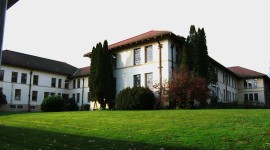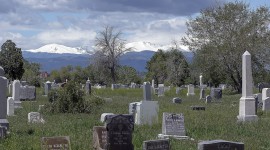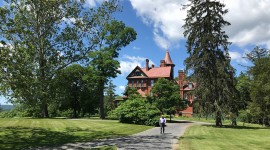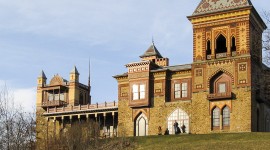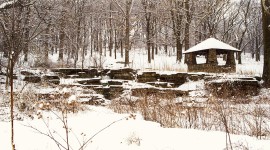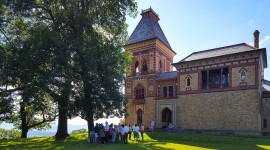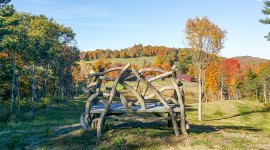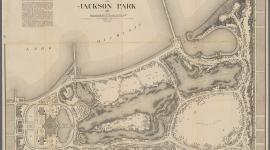Press Releases
The Cultural Landscape Foundation Announces 2009 Landslide Selections: Shaping the American Landscape
|
|
Media Only: Nord Wennerstrom
Wennerstrom Communications
|
Annual Compendium Spotlights Significant Landscapes and Landscape Features at Risk for Alteration or Destruction
Announcement Coincides with Publication of Shaping the American Landscape: New Profiles from the Pioneers of American Landscape Design Project
Washington, D.C. (October 12, 2009) – The Cultural Landscape Foundation (TCLF) today announced the 2009 Landslide theme – Shaping the American Landscape – and the sixteen 2009 Landslide sites. Landslide is an annual compendium of significant landscapes and landscape features at risk for alteration or destruction. The announcement coincides with the publication of Shaping the American Landscape: New Profiles from the Pioneers of American Landscape Design Project, the second volume of an ever-growing encyclopedia covering 250 years of American landscape architects and allied practitioners.
Landslide, established in 2002, examines threatened landscapes (listed thematically, e.g., working landscapes, designed landscapes), and is designed to educate the public about and rally support for these sites. TCLF will support the 2009 Landslide and the new volume of Pioneers, in part, with ten regional conferences. The first five, scheduled for this fall, will be held October 9, The New York Botanical Garden; October 13, Cheekwood, Nashville, TN; October 24, University of California, Berkeley; November 6, the Andy Warhol Museum, Pittsburgh, PA; and, November 13, the Chicago Architectural Foundation (Dates and venues for the spring 2010 conferences will be announced shortly).
Shaping the American Landscape, the newest volume from the Pioneers of American Landscape Design series (University of Virginia Press) took ten years to complete and features 151 illustrated biographical profiles of landscape architects and allied practitioners. The first volume, published in 2000, covers 160 individuals.
The Cultural Landscape Foundation (TCLF), established in 1998, is the only not-for-profit foundation in America dedicated to increasing the public’s awareness of the important legacy of cultural landscapes and the need to help save them for future generations. TCLF advances its mission of "stewardship through education" via its website (which receives more than 6 million web hits annually – 15,000 daily – and continues to grow), conferences, publications, oral history projects, and two significant initiatives: Landslide and Pioneers of American Landscape Design.
Previous Landslides have been accompanied by traveling exhibitions organized in cooperation with and curated by George Eastman House International Museum of Photography and Film, which commissioned original photography of the endangered places. The Landslide exhibition “Heroes of Horticulture” has just concluded at the Reynolda House Museum, Winston-Salem, NC, and “Marvels of Modernism” opens at the Andy Warhol Museum, Pittsburgh, PA, on November 6, 2009. The exhibitions place these landscapes within a broader conversation of art, design and culture, which helps contextualize the significance, value and import of the sites and their designers.
The sixteen 2009 Landslide sites, culled from nearly 100 nominations, feature the work of master landscape architects Frederick Law Olmsted, Beatrix Farrand, George Kessler and Hideo Sasaki, along with architects I.M. Pei and H.H. Richardson. The threatened sites vary in geography, style, type, and scale. The feature can be found online at www.tclf.org
The 2009 Landslide list (alphabetically by state):
Santa Barbara Botanic Garden, CA
This unique collaboration between Lockwood de Forest and Beatrix Farrand is one of the first botanic gardens in America to be planted solely with native plants. Proposed alterations to the historic core of the garden would irreversibly destroy this design legacy. De Forest, with his wife Elizabeth, experimented with various plant types in this nationally-significant, historic designed landscape, and their ideas gained popularity in their influential regional publication, The Santa Barbara Gardener.
16th Street Mall, Denver, CO
The 16th Street Mall, designed by the firm of I.M. Pei and Partners in collaboration with Hanna/Olin, is the last remaining of Denver’s three great modernist urban parks and is threatened with irrevocable change. Among the mall’s many notable features are its innovative custom paving and inviting street furniture that create a pleasant pedestrian thoroughfare.
Riverside Cemetery, Denver, CO
Founded in 1876 as one of the first rural cemeteries in the Rocky Mountain West and designated a National Historic District in 1992, the cemetery’s park-like setting is now threatened by irreversible damage from a loss of water rights to the nearby South Platte River.
City of Hartford Parks System, CT
The City of Hartford Parks system is a wonder. It includes the first municipal park (Bushnell Park, 1854), the first municipal rose garden in America (Elizabeth Park, 1904), and an unrivaled legacy of parks and boulevards that span several decades of involvement by three Olmsteds, ranging from small-scale squares and greens (Barnard Park, ca. 1865) and large-scale municipal works such as Keney Park (1896), the 693-acre career capstone of Charles Eliot’s tenure with the Olmsted office. Today, funding and maintenance are critical issues that threaten these historic landscape resources.
Oakland Cemetery, Atlanta, GA
This rural cemetery, designed in the 1850s, was created as an alternative to traditional and often crowded church graveyards. For more than a century and a half, Oakland has provided comfort for the bereaved as well as a space for passive enjoyment by local residents. In March 2008, a devastating tornado hit the cemetery, toppling centuries-old trees and monuments, and replacing ongoing preservation work with recovery efforts.
Washington Park, Chicago, IL
Washington Park is ranked with New York’s Central and Prospect Parks, and Boston’s Franklin Park, as one of Frederick Law Olmsted, Sr.’s great “country parks.” It is part of Chicago’s South Parks system, the only mid-Western park system designed by Olmsted and his renowned colleague Calvert Vaux. Nonetheless, its stature was not significant enough to save it from the threat of an 80,000-seat Olympic stadium that would have obliterated nearly half the park. Though Chicago’s failed 2016 Olympics bid granted the park a reprieve, the very existence of the threat should serve as a warning about the fragility of even the nation’s most significant park systems.
Scripps Estate, Lake Orion, MI
Bryant Fleming, a renowned landscape architect of the Country Place Era (and co-founder of Cornell University’s esteemed landscape architecture program) was able to integrate the most refined elements of his design vocabulary for the 75-acre Italianate estate of wealthy patron, William E. Scripps. Today, however, a lack of understanding of the site’s early 20th century origins has led to inconsistent and sometimes misguided maintenance, threatening the integrity of the site.
The Elizabethan Gardens, Manteo, NC
In 1953, Richard K. Webel designed The Elizabethan Gardens on Roanoke Island, located at Sir Walter Raleigh’s 1584 landing site, to reflect the era of the colony’s patron Elizabeth I of England. At the gardens, Webel (landscape architect of Lincoln Center’s elegant Damrosch Park) created an innovative series of woodland paths and enclosed gardens rooms, reflecting a keen sense of order and spatial hierarchy. The site’s very existence is threatened by a lack of funding and much needed maintenance.
Olana, Hudson, NY
Perhaps in no other place in America can one witness the extraordinary interface between inspiration and design. Olana, the home and studio of Hudson River School landscape painter Frederic Edwin Church is a remarkable melding of Persian architecture and interior design, the artist’s own work and unrivaled panoramic views of the vast Hudson Valley. Recent winter storms have decimated the estate’s mature tree canopy, leaving many trees and significant portions of the under plantings vulnerable to disease and infestation.
Richardson Olmsted Complex, Buffalo, NY
The Richardson Olmsted Complex, completed in 1895 as the Buffalo State Asylum for the Insane, is the first major collaboration between landscape architects Frederic Law Olmsted and Clavert Vaux. It was designed in partnership with noted architect H.H. Richardson and became a National Historic Landmark in 1986. The city’s protracted economic downturn has resulted in the steady erosion of the site, with its signature Gothic towers. Active local friends groups are vigorously looking for the means to rejuvenate the complex.
Washington Square Village, New York, NY
This early project of Sasaki, Walker and Associates, masters of the Modern movement, represents a harmonious design of architecture, landscape architecture, and art. Today, the modernist design is threatened by the current owner’s proposal to insert a series of buildings, ranging from five to twenty stories, into the garden spaces.
Wilderstein, Rhinebeck, NY
The 1891 Vaux and Company landscape plan for Wilderstein, the estate of Margaret Lynch Suckley, effectively melds a picturesque house, dramatic terrain, and extraordinary scenic views of the Hudson Valley. However, the estate continues to face major challenges including erosion on its steep, south-facing slope, costly damage to drainage culverts, and a dire need for vegetation management solutions.
Elizabeth Lord and Edith Schryver Legacy, Salem, OR
The legacy of the first professional woman-owned practice (active 1929-1970) in the Pacific Northwest is threatened by a lack of awareness of their great contributions to the profession of landscape architecture. Lord and Schryver worked with local growers to encourage propagation of new varieties, and they introduced many East Coast plant species into the Northwest, creating a subtle, but distinctly regional plant palette.
North and South Parks, Allegheny County, PA
Landscape architect Paul B. Riis, inspired by the work of Jens Jensen in the Midwest, created Prairie-style landscapes, noted by a palate of native plants, stratified rock and meandering rivers, in Allegheny County. However, unlike Jensen’s work, which is well known, the historical elements of North and South Parks have suffered from a lack of awareness of their significance and are now directly threatened by budget cuts and benign neglect.
Overton Park, Memphis, TN
George Kessler, often referred to as the Olmsted of the Midwest, designed Overton Park, which was completed in 1906. The park is second only to his celebrated parks and boulevards in Kansas City and Indianapolis (the latter, at 2200 acres, is the nation’s largest National Register District). The park’s main feature, the Greensward, is now regularly used for overflow parking from the adjacent zoo, threatening the park’s original design intent.
Northern State Hospital, Sedro-Woolley, WA
A century before the popularization of healing gardens, the Olmsted firm designed a number of state hospitals and asylums. In recent years, many of these institutions have shifted from state or Federal ownership to other uses, thus putting them at risk. The Seattle commission is part of an extraordinary and diverse collection of landscapes designed by the Olmsted firm in the Pacific Northwest that includes both Seattle and Tacoma’s parks systems. Today, the Sedro-Woolley grounds are threatened by insensitive redevelopment.




